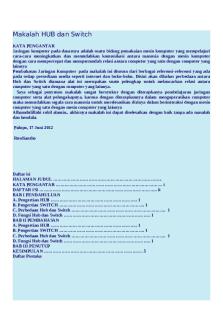Crossbar switch - 12th topic PDF

| Title | Crossbar switch - 12th topic |
|---|---|
| Author | Programmer TRU |
| Course | Current Topics in CS: Introduction to Behavioral Biometrics Authentication |
| Institution | Thompson Rivers University |
| Pages | 9 |
| File Size | 424.7 KB |
| File Type | |
| Total Downloads | 68 |
| Total Views | 147 |
Summary
12th topic...
Description
Router architecture overview two key router functions:
run routing algorithms/protocol forwarding datagrams from incoming to outgoing link
forwarding tables computed, pushed to input ports
routing processor
routing, management control plane (software) forwarding data plane (hardware)
high-seed switching fabric
router input ports
router output ports Network Layer 4-1
Input port functions link layer protocol (receive)
line termination
lookup, forwarding
switch fabric
queueing
physical layer: bit-level reception data link layer:
decentralized switching:
given datagram dest., lookup output port using forwarding table in input port memory (“match plus action”) goal: complete input port processing at ‘line speed’ queueing: if datagrams arrive faster than forwarding rate into switch fabric Network Layer 4-2
Switching fabrics
transfer packet from input buffer to appropriate output buffer switching rate: rate at which packets can be transfer from inputs to outputs often measured as multiple of input/output line rate N inputs: switching rate N times line rate desirable
three types of switching fabrics memory
memory
bus
crossbar
Network Layer 4-3
Switching via memory first generation routers: traditional
computers with switching under direct control
of CPU packet copied to system’s memory speed limited by memory bandwidth (2 bus crossings per datagram)
input port (e.g., Ethernet)
memory
output port (e.g., Ethernet) system bus
Network Layer 4-4
Switching via a bus
datagram from input port memory to output port memory via a shared bus bus contention: switching speed limited by bus bandwidth 32 Gbps bus, Cisco 5600: sufficient speed for access and enterprise routers
bus
Network Layer 4-5
Switching via interconnection network
overcome bus bandwidth limitations banyan networks, crossbar, other interconnection nets initially developed to connect processors in multiprocessor advanced design: fragmenting datagram into fixed length cells, switch cells through the fabric. Cisco 12000: switches 60 Gbps through the interconnection network
crossbar
Network Layer 4-6
Output ports switch fabric
datagram buffer
queueing
link layer protocol (send)
line termination
buffering required when datagrams Datagram (packets)arrive can be lost from fabric faster due to congestion, lack of buffers rate scheduling Priority scheduling – who gets best performance, network neutrality datagrams
Network Layer 4-7
Output port queueing
switch fabric
at t, packets more from input to output
switch fabric
one packet time later
buffering when arrival rate via switch exceeds output line speed queueing (delay) and loss due to output port buffer overflow! Network Layer 4-8
Input port queuing
fabric slower than input ports combined -> queueing may occur at input queues queueing delay and loss due to input buffer overflow! Head-of-the-Line (HOL) blocking: queued datagram at front of queue prevents others in queue from moving forward
switch fabric
output port contention: only one red datagram can be transferred. lower red packet is blocked
switch fabric
one packet time later: green packet experiences HOL blocking Network Layer 4-9...
Similar Free PDFs

Crossbar switch - 12th topic
- 9 Pages

1- Packet Tracer switch
- 2 Pages

Configuring Basic Switch Settings
- 12 Pages

Ejercicios SWITCH-CASE
- 12 Pages

Network switch - Wikipedia
- 10 Pages

Makalah HUB dan Switch
- 4 Pages

the java switch statement
- 11 Pages

Switch Video questions
- 4 Pages

Genetics 12T:12TH - Huwe
- 6 Pages

HW12 - 12th HW
- 4 Pages

12th grade. Science Project.
- 4 Pages

Topic Reading topic reading
- 15 Pages
Popular Institutions
- Tinajero National High School - Annex
- Politeknik Caltex Riau
- Yokohama City University
- SGT University
- University of Al-Qadisiyah
- Divine Word College of Vigan
- Techniek College Rotterdam
- Universidade de Santiago
- Universiti Teknologi MARA Cawangan Johor Kampus Pasir Gudang
- Poltekkes Kemenkes Yogyakarta
- Baguio City National High School
- Colegio san marcos
- preparatoria uno
- Centro de Bachillerato Tecnológico Industrial y de Servicios No. 107
- Dalian Maritime University
- Quang Trung Secondary School
- Colegio Tecnológico en Informática
- Corporación Regional de Educación Superior
- Grupo CEDVA
- Dar Al Uloom University
- Centro de Estudios Preuniversitarios de la Universidad Nacional de Ingeniería
- 上智大学
- Aakash International School, Nuna Majara
- San Felipe Neri Catholic School
- Kang Chiao International School - New Taipei City
- Misamis Occidental National High School
- Institución Educativa Escuela Normal Juan Ladrilleros
- Kolehiyo ng Pantukan
- Batanes State College
- Instituto Continental
- Sekolah Menengah Kejuruan Kesehatan Kaltara (Tarakan)
- Colegio de La Inmaculada Concepcion - Cebu



